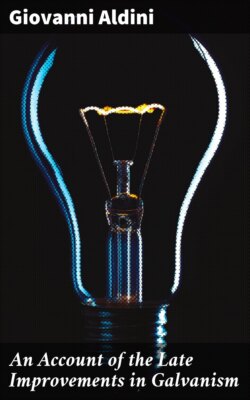Читать книгу An Account of the Late Improvements in Galvanism - Giovanni Aldini - Страница 21
На сайте Литреса книга снята с продажи.
PROPOSITION XVII.
ОглавлениеThe hypothesis of an animal pile, analogous to that formed artificially, seems well calculated to explain the sensations and contractions in the animal machine.
It seems to be proved by the observations of Mr. Davy, Professor in the Royal Institution of Great Britain, and those of M. Gautherot at Paris, that a pile may be composed without any metallic substances whatever. We are therefore naturally led to suppose, that one may be composed also of animal substances alone. Though this has never yet been obtained by art, we behold it with admiration constructed by nature in various animals. If we examine, indeed, the structure of the regular bodies which succeed each other in the torpedo, the electrical eel of Surinam, and in the silurus, we shall find them to be real animal piles, differently arranged: and if an animal pile, exceedingly strong, be capable of communicating a shock, why should not one of a more moderate nature excite that activity which is necessary to produce muscular convulsions? I have already proved, that the system of the nerves and that of the muscles possess different Galvanic powers, or, as it were, different kinds of electricity, to which the animal moisture serves as a conductor. In this point of view, the discovery of the pile of the celebrated Volta, instead of destroying the principle of Galvanism, tends rather in a powerful manner to support it. The object of Galvani’s system is to prove the existence of an animal electricity, and then to explain how its action operates in producing muscular sensations and contractions. The first part of his system rests upon facts, the truth of which neither time, nor the different experiments made by philosophers, have been able to weaken. The second presents an hypothesis which, perhaps, may be further illustrated when the physiology of the human body is better known. Galvani, to explain the activity of animal electricity, supposes the nerves and muscles to be like the Leyden jar; and this idea I confidently adopted. But by the expression ‘Leyden flask’ he meant nothing else than that in the animal machine there are two opposite kinds of electricity, resulting from the nervous and the muscular systems, to which animal moisture continually serves as a vehicle. It was in this sense that he announced his theory of the Leyden flask, in his public lectures, and in his last works. No better comparison was then known, in the language of philosophy, to express this action. It however affords me great pleasure, that I can now substitute for it the pile discovered by Volta, which is perfectly consistent with the system of Galvani; and since I am ready to allow that the invention of the metallic pile gives Volta a title to the discovery of metallic electricity, I hope the discovery of animal electricity, properly so called, will be allowed to Galvani, as similar phænomena are exhibited by the nervous and muscular systems, independently of common electricity.
But some important questions in regard to Galvanism still remain to be answered, such as the following: whether the action of chemical combinations be the cause of Galvanism, or whether Galvanism be the cause of chemical combinations. In my opinion, we have not yet a sufficient number of data to determine this point. It may also be asked, whether Galvanism be of the same nature as electricity, but differently modified by the animal organization. For my part, until their identity be proved by further researches, I shall be contented with admitting that there is a great analogy between them.
But leaving these questions, the discussion of which might be premature, it will be better to deduce general corollaries from the series of experiments already detailed.
COROLLARY I.
It is found that there is a real attraction between certain parts of animals; and this tends to confirm the idea of a sort of atmosphere peculiar to parts of animals, as has been suggested by Humboldt. By these means it will perhaps be one day possible to explain, with less difficulty, the correspondence of some sensations in the animal machine.
COROLLARY II.
The action of Galvanism on the aëriform fluids may serve to explain its influence over the animal fluids by the oxidation of the humours, and other phænomena which hitherto have been explained only in a hypothetical manner.
COROLLARY III.
Fishes, and several amphibious animals which live under water, sometimes approach the surface on certain changes of the atmosphere. When the before-mentioned experiments on the Galvanic atmosphere are considered, we may easily explain, why those changes which take place in distant parts of the atmosphere are communicated to the element in which these animals reside.
COROLLARY IV.
It has been ascertained, that water saturated with salts, and in particular with muriate of soda, contributes a great deal to increase the effects of Galvanism. It is well known also, that fishes, as compared with other animals, possess a very high degree of vitality; and hence we have reason to admire the wisdom of nature in making the sea, which is destined for the abode of fishes, to be abundantly saturated with muriate of soda.
COROLLARY V.
As Galvanism possesses great activity in chemical decompositions, it cannot remain in a state of inaction; but must necessarily produce great changes in the animal fluids and functions.
COROLLARY VI.
This principle, to which some of the grand operations of nature have been entrusted, is not hypothetical; since it has been proved, that as there is a metallic arc and a metallic pile in the mineral kingdom, there is also an animal arc and an animal circle in the animal kingdom; which may one day throw great light on the progress of medicine, and be productive of considerable benefit to the human race.
